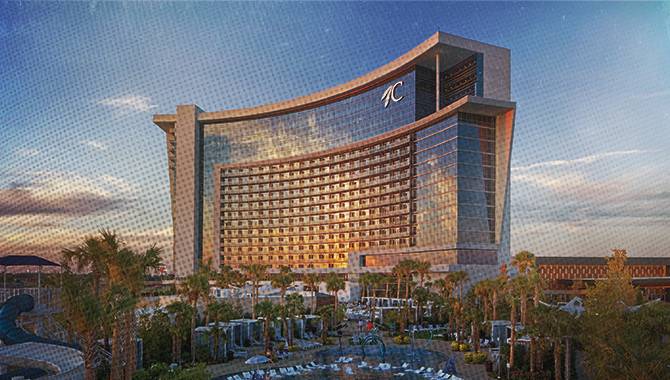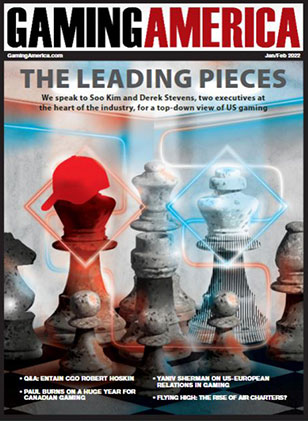
How did JCJ Architects come to design casinos?
Jeanne Muscolino: JCJ has been in operation since 1936. It was really our reputation for high-quality documentation that brought us to the gaming market, and that started with Foxwoods Resorts beginning in the 1990s. We had the opportunity to work with the Mashantucket Pequot Tribe here in Connecticut. From there, our body of work really snowballed. As you know, Foxwoods were pioneers in the industry and the networks that we were able to develop from that one project was really sizeable; carried off across the country. From there, we opened up in California, becoming bi-coastal through an acquisition. Since then, we’ve opened seven offices. Our body of work in gaming encompasses hundreds of projects, a nice split between operations on the commercial side and some of the biggest tribes out there.
What trends do you see emerging in architectural casino design?
Mike Larson: This has been an evolving trend for decades really, but I think we are on a very accelerated path towards a more seamless integration of entertainment into the gaming floor. That spans a pretty wide spectrum, whether it’s music or things you would more traditionally see on the casino floor, to things that are more avant-garde. Sports, especially, is big here. The sports entertainment world is smashing up against the casino world with tremendous force right now. The mergers and acquisitions you see in this industry are tremendous; the partnerships are pretty incredible when you think that, five years ago, you couldn’t have an NFL exhibition game in a city with a casino. That was unthinkable. Now you have sports games in casinos, and sports betting organizations coming together to what everyone thinks is nothing short of an incredible opportunity for growth and integration with a new customer base.
So, we’re seeing that get integrated with casinos in exciting ways. Sportsbooks are an enormous part of our business right now. Even in the last two years, that product has evolved. Everybody is trying to figure out what that means. As those sports betting organizations get more integrated with traditional operators, those ideas are permeating the casino floor. It’s exciting. It’s extending beyond the casino floor too, to food and beverage. There is that urban context, if you will, that is Las Vegas where we see – probably better than any place in the world – sports venues coming in to play with property design, but also civic master planning. People want to create this seamless integration between entertainment, sports and gaming.
Historically, the gaming revenue in the greater resort formula has diminished as other sectors have risen. It’s kind of been the Sands model of 'we have a casino floor but we also have a retail establishment.' Those things kind of become separate entities within the same property, but now have become far more integrated as they come together. The gaming operators are probably more nimble than other industries to take advantage.
JM: I just wanted to elaborate a little bit on Mike’s point. I think it’s really interesting to see how horse betting has driven ties to media. It’s remarkable for me to see dedicated space for media carved out at casinos. You’ve got ESPN at the Lynx, Vision at Circa, Blue Wire at the Wynn. I think that’s something that’s just getting started. But the world of media and technology, and gaming and entertainment, all of these things are coming together in a way that will continue to evolve.
ML: We’re hearing from our clients to that point. Their metrics are changing in how they measure the success of their enterprises. When media comes in, they have metrics that they measure in terms of eyeballs, time and engagement, and things like that. In an abstract way, gaming operators have used those devices in the past but they always have a dollar amount attached to them, whether it’s a table game, or a slot machine or something like that. Now they view things differently, more in line with media companies nowadays, and it’s very interesting. It’s creating many opportunities for just more things on the casino floor.
How do you balance competing interests and parties as you go into the designing of a casino?
ML: There is certainly a level of prioritization in how we go about including the differing opinions of stakeholders. Frequently, there could be two or three, or half a dozen different stakeholders at the table. They’re all part of different groups or organizations. Ultimately, we’ll have a client that takes the lead, and we need to prioritize with them what the most important functions and things to consider are. But, at the end of the day, we have to bring all of these opinions together.
What’s your take on the mass legalization of gambling that is currently happening in the US right now?
JM: It’s absolutely exciting. It’s really interesting to see the level of sophistication that local operators achieve when they are competing on a national level, with the commercial operators that are largely coming out of Las Vegas. It’s raising the game for everybody and it’s exciting in terms of bringing products to areas that haven’t had it before. It’s also exciting when you look at bringing a gaming opportunity or a gaming product to urban centers. You look at the licensing opportunities that they’re talking about downstate in New York and what that might mean for New York City. Everybody is salivating at the opportunity if Texas ever opens its doors and what that might mean to urban centers like Dallas. That’s very exciting. It’s interesting to consider what the integration of gaming facilities might mean for the urban centers around the country.
What significant projects does JCJ Architecture have in the pipeline?
ML: JCJ Architecture has a wide range of gaming projects across the country, both recently completed and in the pipeline. The firm is currently working on multiple projects for several of the gaming industry’s notable brands, including MGM Resorts, Bally’s, Resorts World, and Penn National.
For Penn National, JCJ just completed Hollywood Casino York and anticipates the opening of Hollywood Casino Morgantown in a few weeks (at press time). Both projects are in Pennsylvania. The firm is also collaborating with Caesars on the rebrand of Harrah’s New Orleans, to its namesake Caesars brand.
Also in the pipeline for JCJ is DraftKings at Casino Queen in St. Louis, Illinois, a project that will introduce a sportsbook and dining promenade with new food and beverage options to the existing casino, to enhance the guest experience. This August, JCJ Architecture wrapped completion on the major expansion of the Choctaw Casino & Resort in Durant, Oklahoma, as well as the FireKeepers Casino Hotel expansion in Battle Creek, Michigan. Both projects involved greatly increased the amenities of the existing campuses.
Do you have any final comments for our readers?
JM: As we talk about the entertainment component, there are a lot of new players coming to the market, a lot of new partnerships being formed, whether it's in Las Vegas or elsewhere. There are new ideas and operators coming to the casino floor and they’re bringing with them new partnerships.
Entertainment partners, food and beverage partner, all of that is the fuel for innovation. I think we are on the cusp of a new phase of that in the industry and we’re really looking forward to it.

